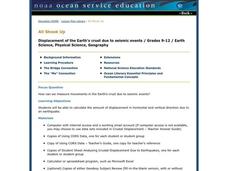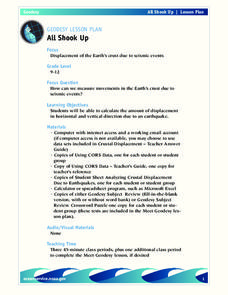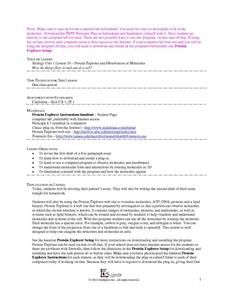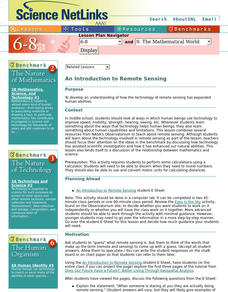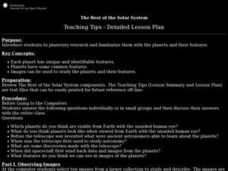Curated OER
All Shook Up
Students calculate the amount of displacement after an earthquake. In this seismic event lesson students research the Internet, and fill out a CORS data sheet.
Curated OER
Natural Disaster Risk at Home
Students analyze the natural disater threat and potential mitigation techniques of their (parents?) home. They apply classroom knowledge to students, non-academic daily life. Students recongize how earth processes specifically affect...
Curated OER
All Shook Up
Students measure movements in the Earth's crust due to seismic activity. Students calculate the amount of displacement in horizontal and vertical direction due to an earthquake.
Curated OER
How do things flow in and out of a cell?
Students use a word processing program successfully. They are able to complete a final draft of a Lab Report and turn in all drafts for a formal letter grade. Students finish type their Lab Reports, they are reminded to use the spell...
Curated OER
My Biotic Creation
Eighth graders explore different ecosystems. In this ecosystem survival lesson conditions lesson students create their own fictional creature.
Curated OER
Game 3-1
In this vocabulary learning exercise, students answer the question, "What is it?" to identify the object in each picture. Each picture features a part of the body. The learning exercise is intended for use with English language learners.
Curated OER
Animals for Kids
In this vocabulary worksheet, students match the black and white drawings of ten animals with their names. Animals include a rhino, giraffe, elephant, crocodile, zebra, lion, monkey, dog, tiger, and cat. The worksheet is intended to be...
Curated OER
ESL The Body Word/Picture Matching Worksheet
In this ESL body parts worksheet, students examine 10 small pictures of body parts. They match the pictures to the words that name them such as toes, fingers, nose, and eyes.
Curated OER
It's Not Your Fault
Young scholars study the San Andreas Fault, calculate its movements, and compare the movements on both sides. In this earthquake lesson students use the Internet to track movement, and calculate movement using a spreadsheet.
Curated OER
North Carolina State Plants
Fourth graders identify the state plants by describing clues to different contestants. They play a game in which the class gives hints to the contestants about what state plant the teacher held up. The first contestant to guess the...
Curated OER
Writing About Winter
Students investigate the concept of winter as a season and they write an essay as a reflection upon the acquiring of new information. The class should have a list of vocabulary or a word wall available for observation to aid in the...
Curated OER
Sampling Rocks
Pupils study rocks they find on the playground. In this investigative lesson plan students collect and analyze rocks they find and answer questions about them.
Curated OER
Ups and Downs
High schoolers examine tidal currents. In this tides lesson students describe how the tides affect lives and explain why it is important to monitor them.
Curated OER
Environment: Renewable Energy Sources
Students, in groups, conduct Internet research on various renewable energy sources. The groups create several multimedia slides for inclusion in a class presentation. Topics covered include solar, nuclear, and geothermal power.
Curated OER
Water and Ice
Young scholars explore water as it changes states of matter. In this physical property lesson, students use observation, measurement, and communication skills to describe changes in water as it goes from a solid to a liquid and back again.
Curated OER
Matter: Three States of Matter
Learners discover characteristics of each of the three states of matter: solid, liquid and gas.
Curated OER
LLoyd's Corner
Students write a description of how a local environment has changed over time and why these changes have occurred accordingly. They describe and record changes in Lloyd's corner over time as depicted in pictures taken at four different...
Curated OER
Mapping Your Schoolyard Habitat
Learners explore the terrain, structures, plants and signs of habitats around their schoolyard. They draw a sketch map showing the different areas around the schoolyard. Students identify the location of weeds and native plants on their...
Curated OER
Three States of Matter
Students explore the three states of matter. In this matter lesson, students are shown a variety of examples and decide whether it is a liquid, solid or gas. Students brainstorm what characteristics the objects in each group share.
Curated OER
Solar System
Pupils analyze theories on how the solar system was formed. In this solar system instructional activity students explain the rotation and revolution of motion.
Curated OER
Are you a river keeper?
Students perform healthy water practices by discussing and demonstrating acts of philanthropy. In this healthy water lesson plan, students read an article on how we can keep water clean, and create a LITWIS activity.
Curated OER
Thunderstorm Outflow
Students list at least three physical characteristics of a thunderstorm outflow. They explain what physical process occurs in a thunderstorm to create the storm's outflow, and locate the thunderstorm's outflow.
Curated OER
The Best of the Solar System (Grades 4-7)
Students explore planetary research and become familiar with the planets and their characteristics. They compare and contrasts planets and moons.
Curated OER
The Best of the Solar System (Grades 6-8)
Learners are introduced to planetary research and become familiar with the planets and their features. They view images of the planets, and fill in an information chart which is imbedded in this plan.


